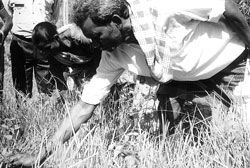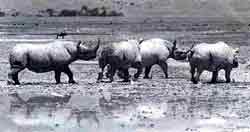
The parching of India's Venice
Kerala finds its rivers drying up and beginning to die

Kerala finds its rivers drying up and beginning to die

Six years ago, the Andhra Pradesh government decided to manage forests jointly with the people. This effort is breaking new ground in Naxalite infested areas of the state

The Central Public Works Department has banned the use of wood in its construction projects, ignoring the fact that the substitutes are more ecologically harmful and mainly depend on non renewable sources of raw materials

Despair and devastation stare India"s artisans in their face, as resource crunch, modern civilisation and government apathy combine in an onslaught on their teetering citadels. Down To Earth presents an exhaustive analysis

With timber being harvested from Papua New Guinea's tremendous forest wealth at an unsustainable rate, the customary owners of forest land are now asserting themselves and claiming compensation as well as a share of the profits. But an insensitive bureauc

Issues relating to the environment, though not on top of the agenda, did make their presence felt in the just concluded assembly elections.

Following economic liberalisation, India's largest power equipment manufacturer BHEL is diversifying and exploring renewable energy technologies in order to meet the stiff competition it faces from multinationals.

Under the 1983 act, the village assembly the lowest level of panchayati raj, from where the primary inputs for development should have come was the most neglected.

UNCED has thrown into sharp focus all matters environmental international industry, quick to Catch on to now trends, has started branding its technologies environment friendly and in some cases, started looking for less wasteful ways

In India, the issue of food security has always been intimately involved with that of ecological degradation. In 1he late '60s and early'70s, the green revolution was introduced to increase food

Extraordinary court rulings on two rivers in south India set the stage for a showdown between environmental agencies and the industry

Beyond the Thar's austere barrenes, a battle of survival rages between the region's treasure trove of floral diversity and marauders like humans, animals and weather

Red rot, a fatal fungus eating into the sugarcane crop in western Uttar Pradesh, has left India drastically short on sugar. BIJOY BASANT PATRO finds a countryside caned to death

<p><span style="font-size:14px;"><strong>Food Safety in Sri Lanka</strong></span></p> <p><img alt="" src="http://www.indiaenvironmentportal.org.in/files/country/srilanka/foodsafety_hl.jpg" style="width: 530px; height: 300px; border-width: 2px; border-style: solid;" /></p> <p style="text-align: justify;">In Sri Lanka there is a Food Control System under the Ministry of Healthcare, Nutrition and Uva Wellassa Development. Director General of Health Services is the Chief Food Authority and also the Chairman of the Food Advisory Committee (FAC) established in terms of the Food Act No. 26 of 1980. The FAC is comprised of 19 members. They represent various stake-holders in food safety from Government Departments / Ministries as well as trade and consumers. There is also a Food Advisory Technical Sub Committee that deliberates on issues referred to it on a regular basis. The main function of the FAC is to advise the Minister in charge of the subject of health on food safety policy matters. The Food Control Administration Unit is in charge of the general administration of regulatory and training activities of the country. </p>

A programme in Zimbabwe strives to conserve wildlife and maintain development on the premise that villagers will utilise natural resources in a sustainable manner if they can perceive the benefits to them

West Bengal is making what could be another step towards village self rule, where villagers, including women, will decide what is best for them, but hunger for power and male hegemony may set things back.

Governments and the masses have very rarely worked together successfully in modern India. In Madhya Pradesh, chief minister Digvijay Singh has managed to do that. The state government's watershed management programme in the district of Jhabua has m

The government's employment generation schemes, laudable though they may be, have yet to achieve their goals. Not involving intended beneficiaries is cited as a major reason for their failure.

The Adarsh Gaon Yojana was set up to empower some 300 villages in Maharashtra. After eight long years, it is yet to show results. The people involved hold the state"s apathy and the red tapism responsible for the failure of this rural dream of self-suffic

Kerala launches a movement of the people, by the people, for the people. Whether the movement will stand the test of time is yet to be seen, but enough is taking place in the state now to be optimistic about the future